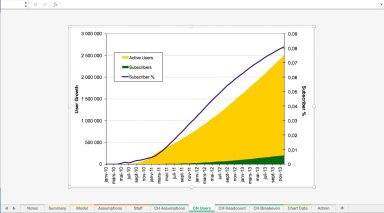
Last version published: 24/01/2017 15:51
Publication number: ELQ-81028-3
View all versions & Certificate

Freemium Business Model
Customize a ready-made financial model for your Freemium Web Services Business
Further information
Apart from the obvious fact that you need Investors to understand you, below are a few of the reasons for why you need to have a financial model:
o Further clarifies your goals and assumptions.
o Breaks down your business' pressure points for better understanding.
o Enforces you to truly captivate your scaling cost structures
o Pushes you to look deeper into your cash needs and realize your milestones
o Allows you to have a constantly updated document in which you can track, structure and bring focus to your business analytics- Think of it as a product, it is a continual process.
o It actually helps all your team to understand what it is your firm is aiming at, and helps you set those expectations when something needs to be done and how long it will take to do so. It might take a few guesses, but it is vital that your team is on the same mindset when it comes to goals, assumptions and time management!
o This may not be needed, but you come across it, it provides a document where everyone can sign off on, to reduce potential selective blaming when things don't go so well.
Source: Giff Constable, www.giffconstable.com, 5th November 2009
I suggest a few things that you may need to search for or guess if you are really at a very early stage:
o Further look into comparables on user growth rates, marketing spend and churn
o customer acquisition / sales methods and costs
o price points and customer conversion rates that depends on your business model and category.
o payment processing rates and fraud/chargeback levels
o contractor and salary rates (both “startup discounted” and market) for your hires
o customer support method and costs , and how it scales with customers
o true travel costs (often underestimated)
o expected concurrency rates and visit frequency
o download size per visit
o architecture scaling: owned vs managed hosting vs cloud and how servers and costs scale
Focus your efforts on a model that feels ambitious but doable, but don’t forget to create a conservative “oh shit” version, and if it has to be a sales document, you may need a “$best case ka-ching$” version as well.
Here are a few key things you want to examine out of your model:
o are there any variables where a slight variation makes a massive difference?
o are your fundraising milestones well matched to your product and financial milestones?
o when do you hit monthly breakeven?
o how many users do you need to have acquired / kept to get to breakeven?
o how much money have you spent in total to get to breakeven?
o are you adequately scaling costs to meet the demands of a large user base in later years?
o can you believe any of it! You can make a model spit out whatever numbers you want, so cross-check, second-guess, and don’t buy too deep into your own assumptions and guesses!
Source: Giff Constable, www.giffconstable.com, 5th November 2009











